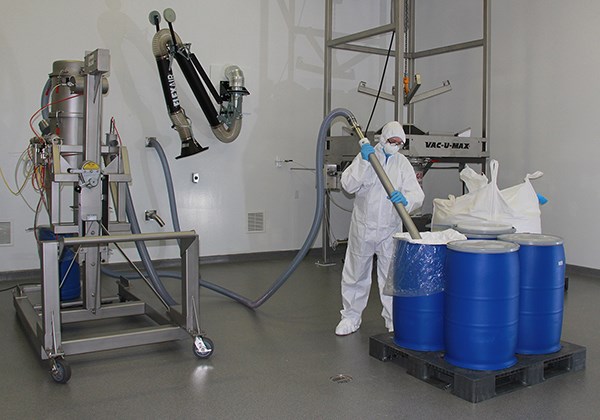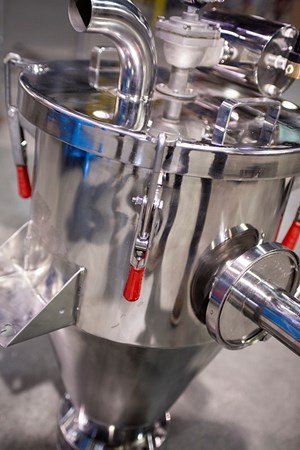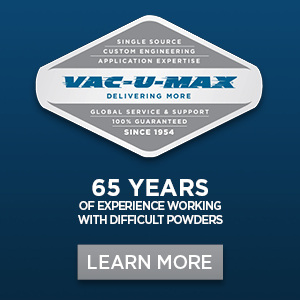Need a Better Way to Convey Powders from Point A to Point B?
Sponsored ContentVacuum conveying systems for powders and difficult-to-convey materials involves a starting point and a destination where hazards need to be avoided along the way. Here are the top 10 tips to design a system to maximize movement and minimize dust exposure.
Share
Read Next
Vacuum conveying technology is a clean, efficient, safe and worker-friendly way to move materials around a plant. Incorporating vacuum conveying for handling powders and difficult-to-convey materials, eliminates manual lifting, stair-climbing with heavy bags, and messy dumping, all while avoiding many hazards along the way. Learn more about the top 10 tips to consider when designing vacuum conveying systems for your powders and granulars. Automating your bulk material handling process maximizes material movement, and minimizes dust exposure and other hazards.
Top 10 Tips to Consider When Designing Vacuum Conveying Systems
Vacuum conveying controls dusts by eliminating hand scooping and dumping, delivering powders in an enclosed process without fugitive dust. If leaks occur, the leak is inward, unlike with positive pressure systems that leak outward. In Dilute Phase vacuum conveying, material is entrained within the air stream, with a complimentary ratio of air and product.
System controls allow material to convey and discharge on demand, ideal for larger applications requiring movement of bulk materials from larger containers such as bulk bags, totes, rail cars, and silos. This is accomplished with little manual intervention, reducing frequent container changes.

Dilute Phase: Product material is entrained in air stream in equal “Material-to-Air” ratio.
Typical conveying rates in dilute phase may go up to 25,000 lb./hr. with typical conveying distances of less than 300 feet and line sizes of up to 6" diameter. For smaller “Up-and-In” conveying applications with conveying rates of less than 0.25 cubic feet per minute, conveying line sizes start at 1.25" in diameter.
To properly design a pneumatic conveying system, it is important to define the following criteria in your process.
1. Know Your Bulk Density
As a first step, it is important to know more about the powder that is being conveyed, specifically its bulk density. This is typically described in pounds per cubic feet (PCF) or grams per cubic centimeter (g/cc). This is a key factor in calculating the size of the vacuum receiver.
For example, lighter-weight powders need larger receivers in order for the material to fall out of the air stream. Bulk density of the material is also a factor in calculating the size of the convey line, which in turn determines the vacuum producer and conveying velocity. Higher bulk density materials require faster transport velocity.
2. Know Your Conveying Distance
Conveying distances comprise both horizontal and vertical factors. A typical “Up-and-In” system offers a vertical lift from the floor level, conveying up to a receiver over an extruder or loss-in-weight feeder.
It is important to know the quantity of 45-degree or 90-degree sweep elbows needed. “Sweep,” in general, refers to a large centerline radius that is typically 8-10 times the diameter of the tube itself. It is important to keep in mind that one sweep elbow is equivalent to 20 ft. of 45 degrees or 90 degree of linear tubing. For example, 20 ft. vertically plus 20 ft. horizontally and two 90-degree elbows equals at least 80 ft. of conveying distance.
3. Know Your Conveying Rate
When calculating conveying rates, it is important to consider how many pounds or kilograms per hour will be conveyed. Additionally, define whether the process is batch or continuous.
For example, if a process requires conveying 2,000 lb/hr. of product, but the batch process requires conveying 2,000 lb every 5 minutes for 1 hour, this really amounts to 24,000 lb/hr. This is the difference between 2,000 pounds in 5 min. vs. 2,000 pounds over a 60-minute period. It is important to know the demands of the process in order to properly size the system to determine the convey rate.
4. Know Your Bulk Materials Characteristics
In the plastics industry, there are many different bulk material characteristics, particle shapes and sizes.

Bulk material characteristics play a vital role in properly sizing vacuum receivers and filters.
Here are a few material characteristics:
- Fine
- Cohesive
- Floodable
- Free-flowing
- Abrasive
- Or combustible.
Make sure to identify whether your material comes in the form of:
- Powders
- Pellets
- Flakes
- Granules or others.
Understanding particle size and distribution is very important when sizing the receiver and filter assembly, for either mass flow or funnel flow distribution.
Other considerations include defining whether the material is free-flowing, abrasive, or combustible; whether it absorbs moisture; and whether there potentially could be chemical compatibility issues with conveying hoses, gaskets, filters, or process equipment. Additional characteristics include materials that are “smoky” like talcum powder, which has a high “fines” content, requiring more filter area. For non-free flowing materials with high angle of repose, special considerations need to be given to the receiver design and discharge valve.
5. Know How the Raw Materials Are Received
When designing a vacuum conveying system, it is important to clearly define how the materials are received and introduced to the process. There are many ways of introducing materials into a vacuum conveying system, some more manual, while other more suitable to automation—and all require attention dust control.
Material can be received in:
- Paper bags
- Fiber drums
- Bulk bags
- Super sacks
- Rigid intermediate containers
- Silos or day bins
- Railcars
- Bulk trucks
- Or other upstream process equipment.
To maximize dust control, bulk bag unloaders incorporate enclosed vacuum conveying lines and bag dump stations integrate dust collectors. Material is conveyed from these sources by filter receivers, and then conveyed to the process.

6. Know your Upstream Process
To properly design a vacuum conveying system, you must define the upstream process that is supplying the material. Find out if the material is coming from a loss-in-weight feeder, volumetric feeder, mixer, reactor, extruder hopper or any other equipment used to move material. These all influence the conveying process.
Additionally, the frequency of the material coming out of these vessels —whether batch or continuous — affects the conveying process and how the material will behave when it comes out of the process. Simply put, upstream equipment affects downstream equipment. It is important to know everything about the source.
7. Know Your Headroom Requirements
This is an especially important consideration when installing equipment into an existing plant. What may have been designed for manual operation may not offer enough room for an automated process. Even the smallest conveying system for powder handling will require at least 30 inches of headroom over your process, taking into consideration maintenance requirements for filter access, discharge valve inspection, and access to equipment below the conveyor.
Applications requiring high throughput rates, which require large headroom, can use a filterless vacuum receiver. This approach allows some carryover dust to pass through the receiver, which is collected in another ground-level filtered vessel. Scaling valves or positive pressure systems may also be a consideration for headroom requirements.
8. Is Your Process Batch or Continuous?

Vacuum receiver refilling feeder as part of continuous process.
It is important to define the type of operation that you are feeding/refilling— batch or continuous. For example, small conveyors discharging into a surge bin is a batch process. Know whether a batch of material will be received in the process via a feeder or an intermediate hopper, and whether your conveying process can handle the surge of material from a batch.
Alternatively, vacuum receivers may use feeders or rotary valves to meter the material directly into the process— that’s continuous conveying. Or, material can be conveyed into the receiver and discharged at the end of the conveying cycle in a metered way. Extrusion applications typically utilize both batch and continuous operation, feeding materials directly into the mouth of the extruder.
9. Know Your Geographic or Atmospheric Conditions
Geographic and atmospheric considerations are important design considerations, particularly where altitude plays an important part in sizing the system. The higher the altitude, the more air is required to convey the material. Additionally, consider plant environmental conditions and temperature/humidity control. Certain powders that are hygroscopic can have discharge problems on humid days.
10. Know the Materials of Construction
Materials of construction are critical in the design and functionality of a vacuum-conveying system. The focus is on product-contact surfaces, which are typically all metallic—plastics are not used for reasons of static control and contamination. Will your process materials contact coated carbon steel, stainless steel, or aluminum?

Stainless Steel Vacuum Receiver – various finishes and materials of construction are available.
Carbon steel is available with various coatings, but those coatings can deteriorate or degrade in use. For food- and medical-grade plastics processing, 304 or 316L stainless steel is the choice—no need for coatings—with a specified level of polish for ease of cleanliness and to avoid contamination. Maintenance and quality-control personnel care deeply about their equipment’s materials of construction.
VAC-U-MAX is a worldwide leader specializing in the design and manufacture of vacuum conveying systems and support equipment for conveying, weighing and batching over 10,000 powders and bulk ingredients.
VAC-U-MAX has many firsts, including the development of the first air-powered venturi, the first to develop technology for direct-charge loading of vacuum tolerant process equipment, and the first to develop the vertical-wall “Tube Hopper” material receiver. Additionally, in 1954 VAC-U-MAX developed the world’s first air-operated industrial vacuum cleaner built on a 55-gallon drum for a combustible dust application.
Want to learn more about how to convey bulk powders in your plant?Please visit VAC-U-MAX.com or call (800) VAC-U-MAX.




